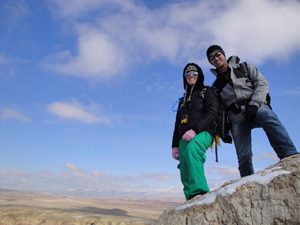Team taught by Professors Larry Malinconico and David Sunderlin, new two-semester class includes field work in Bighorn Basin, Wyo.

Geology professors
Larry Malinconico and
David Sunderlin have combined two upper-level geology courses into an innovative, two-semester class structure.
The new team-taught course, Basin and Structural Analysis: Integrated Teaching in a Tectonic Framework, is supported by a Fund for Faculty Innovation grant, awarded by the Office of the Provost. The first section of the course is being taught this semester, and students will continue the sequence in the fall.
The revised curriculum covers the material previously taught in Geology 215, Modern and Ancient Depositional Environments, and Geology 317, Structure and Tectonics of the Earth. Under the new structure, students will also participate in a five-day, off-campus field experience in Bighorn Basin, Wyo., that will allow them to apply the techniques and skills they learn on campus to a real-world project.
The professors hope the shared field experience will promote a greater sense of community between geology majors and faculty and the addition of the experience may be a draw for students into the geology program. They also believe this intra-disciplinary approach could provide a model for geology departments at other colleges and universities.
“It is important for students to understand that these are not separate disciplines, but rather, when conducting examinations of geological field sites, they learn to make their interpretations in a holistic fashion incorporating all the information at their disposal,” says Sunderlin.
Although the new course began this spring, the geology professors conducted a trial run of the field project in Bighorn Basin last October. Students in Malinconico’s Geology 317 course participated in the project over fall break.
The work gives students the opportunity to integrate the disciplines of sedimentology and structure. It included students constructing a geologic map of the Sheep Mountain field area in the basin, drawing structure cross-sections through the area, interpreting and summarizing local and regional geologic history, and developing oral and written presentations of their work.
 Geology professors Larry Malinconico and David Sunderlin have combined two upper-level geology courses into an innovative, two-semester class structure.
Geology professors Larry Malinconico and David Sunderlin have combined two upper-level geology courses into an innovative, two-semester class structure.